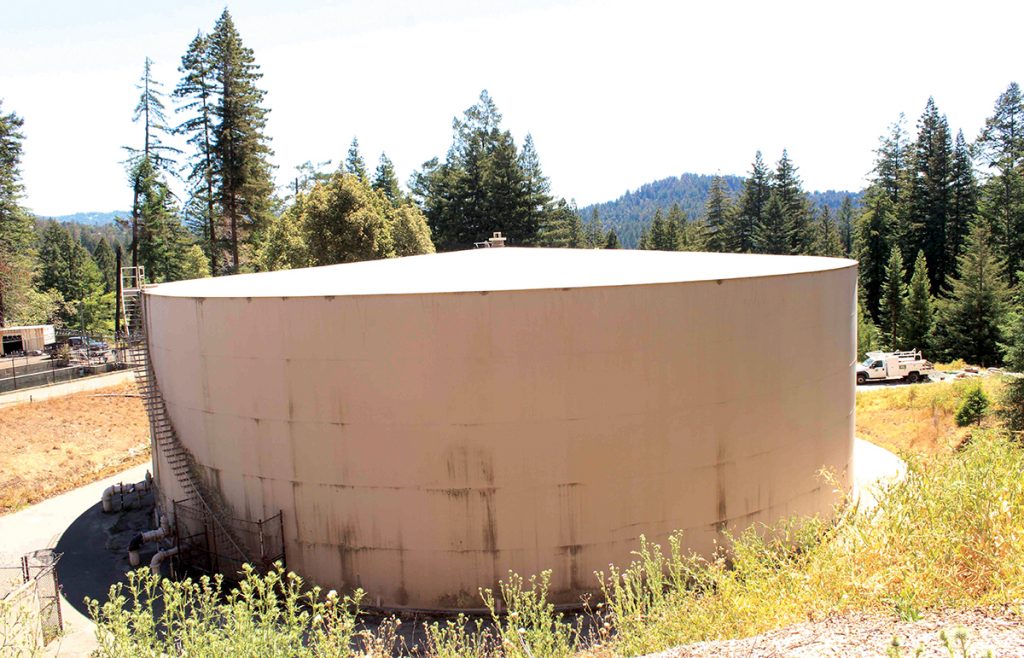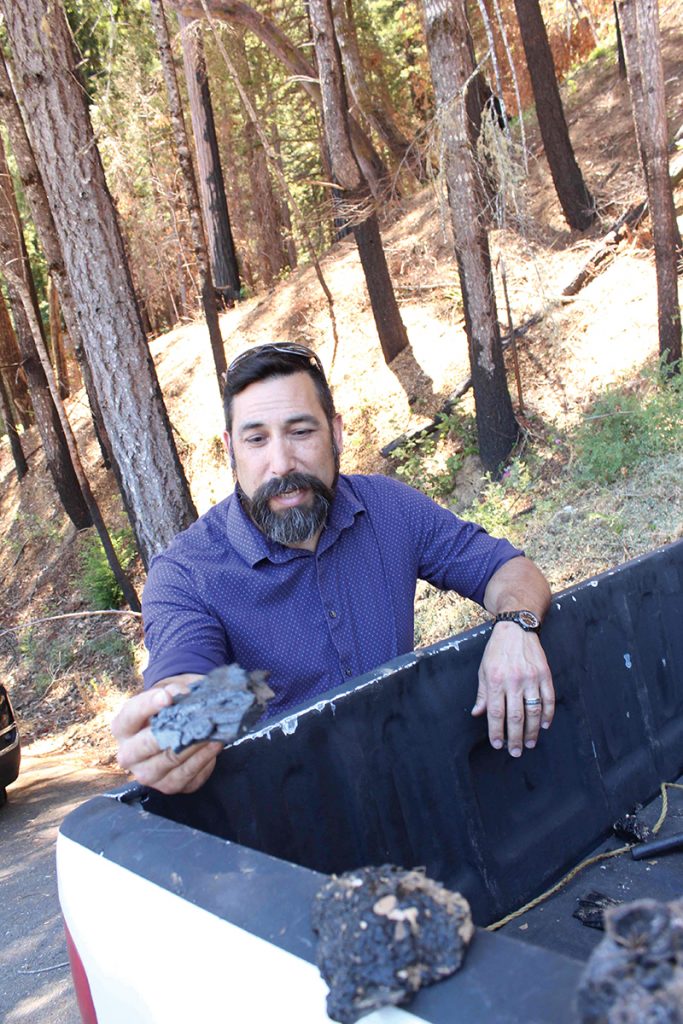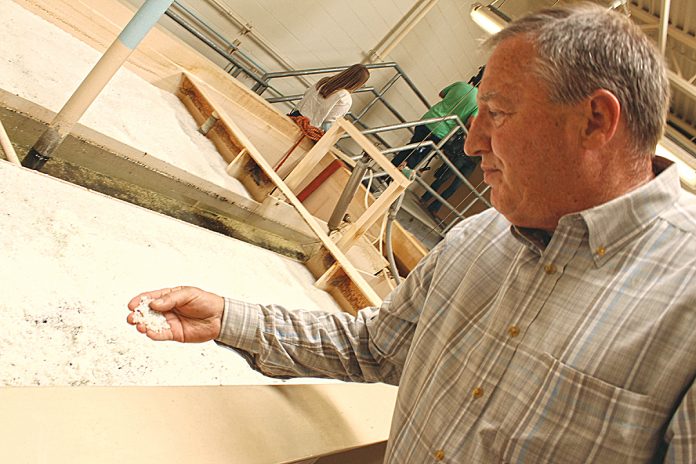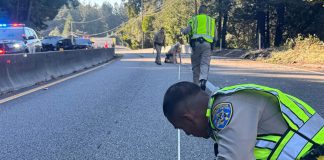The humming, buzzing and echoing inside the Boulder Creek facility that prepares drinking water for the San Lorenzo Valley makes one feel like they’re at an aquatic center. That the San Lorenzo Valley Water District uses a chlorine disinfection process (sodium hydrochloride)—alongside the tiny plastic balls it deploys to physically remove unwanted mountainside particles—only adds to the similarities with a pool. The large pipes, twisting at 90-degree angles, suggest Super Mario could appear at any minute. And the Cold War-era backup instruments in the control room hint at design choices put in place to protect against catastrophe.
What happened there last year was as dramatic as any video game: the CZU Lightning Complex fires swept through, wiping out 50% of the site’s storage capacity, releasing toxic compounds towards nearby taps, as seven miles of pipe melted. The district took out a $9.2 million loan to tide it over until government disaster aid and hoped-for extra cash from ratepayers can start flowing. There’s so much Federal Emergency Management Agency (FEMA) paperwork to do it’s piling up in Operations Director Rick Rogers’ truck. But he’s confident $15 million—FEMA’s 75% of the $20 million Rogers says it will take to rebuild—will be on its way, soon enough. So now, the district is working on winning support for a proposed surcharge costing the average customer about $10 per month for five years, in order to come up with the other $5 million.
Not everyone supports the idea. In a July 2 Press Banner op-ed, Bob Fultz, a water district board member, suggested ratepayers should take a fine-tooth comb to the district’s finances before moving ahead with the surcharge plan.
The ask comes as the district has just emerged from a contentious process where it looked at whether to merge with the Scotts Valley Water District or not.
“I was involved with that, but our board said ‘no’—a hard no,” Rogers said. “We were worried Scotts Valley wanted our water, you know, with all the growth that they have down there.”
Since the entire state has plunged into a drought again this year, residents fear wildfires could return and impact the underground water resource that both Scotts Valley and the San Lorenzo Valley draw from, called the Santa Margarita Groundwater Basin. San Lorenzo Valley is currently getting about 80% of its water from the basin, up from around 40% in more normal times. According to district officials, this has already started to put pressure on the aquifer that it won’t be able to handle long-term. However, they say there’s no indication below-ground source levels have been dropping—yet.
During a media day held July 7 at the Boulder Creek treatment plant, Rogers recalled the harrowing days last year when they almost lost everything.
“We monitored the fire with our consultants through satellite heat maps, and we were able to track the fire almost hourly as it got closer and closer to our facilities,” he said. “We were able to see the fire coming down to the supply line into our intakes, and that gave us the ability to shut down the treatment plant, so no contamination came in.”

Two district staff members were at work, trying to help protect the community’s drinking water supply, while their homes burned down, Rogers said.
Nate Gillespie, water treatment and system supervisor, said the organization quickly issued a Do Not Drink/Do Not Boil advisory, and noted in the weeks after the fire, workers collected about 500 samples to check for potential contaminants.
“We ultimately did discover benzene in the distribution piping in Riverside Grove,” he said.
On Sept. 3, they took a reading that showed there was 42 times as much benzene as allowed in that neighborhood. By Sept. 16 it was back under the 1 part per billion limit.
In the same area, they’d also discovered some tetrachloroethylene, a volatile organic compound believed to cause cancer, but at .77 parts per billion, this was still below the legal threshold. The district continues to test at the location monthly, just to make sure levels don’t spike again. Minor detections of toluene, ethylbenzene and xylenes kept showing up on samples at other locations (Pinecrest and Middleton, as well as at the Huckleberry Tank). After the district took some of its equipment out of service and flushed others, it hasn’t seen any re-contamination, a problem faced by other jurisdictions in California hit by wildfires, Gillespie said.
Christine Patracuola, co-owner of Rocky’s Café in Felton, says she believes the district did “the best it could” when it came to keeping local residents safe after the fire, even though it led to tough decisions about her business.
“We were worried,” she said. “We used bottled water during that time.”
But she says it took the district months to help her figure out why the restaurant’s bill topped $200 during the second lockdown before Christmas, despite doing less dishwashing after switching to paper plates.
“I had no idea what the heck was going on,” she said, adding business has picked up, yet she’s now being charged less after her bill suddenly plummeted again. “My concern is the overall picture.”

Rogers says he believes the Rocky’s Café situation likely represents a “unique set of circumstances,” noting workers have continued to check meters regularly. While the district did give money back to customers whose bills spiked after the fire—and shut off service for victims with torched homes—he notes they didn’t offer rebates to anyone whose water bill remained constant. And they haven’t turned off service for customers who haven’t paid during the pandemic, either, as required by law.
Patracuola says she hasn’t received a rebate.
Rogers knows there are plenty of challenges ahead for locals who want to return.
“These are all houses that burned down,” he says, while driving down the hillside past tents and campers, as a contractor arrives to fix the coating on the inside of one of their main water tanks. “This area’s going to have a hard time rebuilding because of septic compliance.”
And it’s not going to be easy for the district either, given how much of its system is in remote terrain. Josh Wolff, the district’s engineering manager, said San Mateo-based Freyer & Laureta, Inc. has been handed a nearly $250,000 contract to complete a feasibility study.
“From an engineering perspective, it’s pretty straightforward,” he said. “What we can actually do is really the question.”








